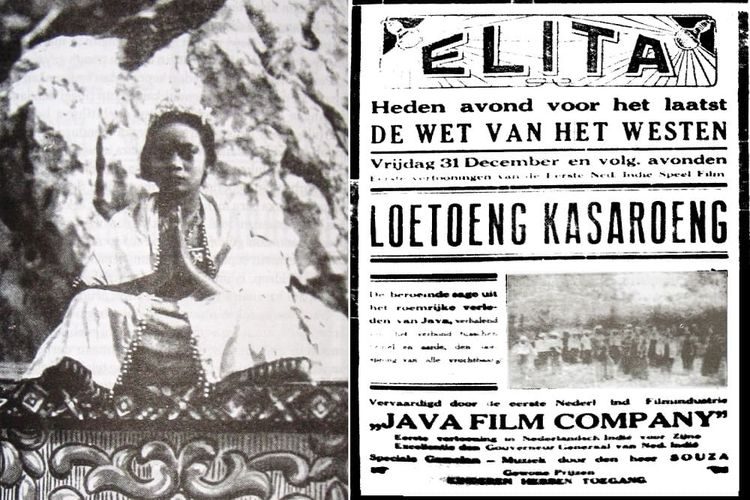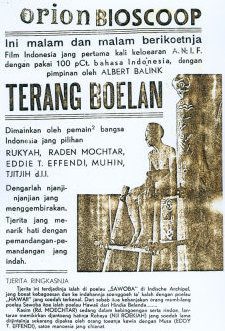Indonesian cinema did not immediately emerge as a complete cultural entity from the outset. As discussed in the previous article (Indonesia’s Film Industry: A Long Journey), the historical trajectory of national cinema began with the emergence of Loetoeng Kasaroeng (1926), Boenga Roos dari Tjikembang (1931), Pareh (1936), Terang Boelan (1937), and Darah dan Doa (1950). However, why was Darah dan Doa chosen as the milestone for National Film Day on March 30? To answer this question, let us revisit how this long history shaped the identity of Indonesian cinema until it finally found its own voice.
The Unresolved Legacy of Colonial Cinema

The first historically recorded film in the Dutch East Indies was Loetoeng Kasaroeng (1926), directed by L. Heuveldorp and produced by Algemeen Photostudio. This film, based on a Sundanese legend, was indeed made on the land that is now Indonesia. However, the entire production process was managed by the colonial authorities: the capital, crew, and distribution were all aimed at European audiences. Therefore, although this film marked the beginning of local cinema development, it was never truly considered an Indonesian film in the cultural and national sense.
Boenga Roos and Soundtrack Experiments

By the 1930s, sound technology began to penetrate the local film industry. The Teng Chun released Boenga Roos from Tjikembang (1931), a film adaptation of a Malay novel featuring dialogue and kroncong music. This film became a pioneer in local sound films and was quite popular among indigenous audiences. However, once again, capital ownership and creative control remained in the hands of Peranakan Chinese entrepreneurs and immigrant creative teams. National identity remained a backdrop, not the core of the story. Thus, despite its technical significance, this film was not yet sufficient to be called an Indonesian cinema in the true sense.
Pareh and Terang Boelan: Aesthetic Triumph Without National Roots


The years 1936 and 1937 witnessed the emergence of epic films such as Pareh and Terang Boelan by Albert Balink and Wong Bersaudara. Pareh visually captivated audiences with its portrayal of Javanese peasant life, while Terang Boelan transported viewers to a romantic beachside tale with a musical flair. Both films were aesthetically and commercially successful, even considered to have opened up a wider film market. However, behind the scenes, these stories were still directed to meet the expectations of the colonial market, not to build a national narrative. Therefore, despite their cultural proximity, these films cannot yet be considered truly independent Indonesian films.
Japanese Propaganda Films and the Loss of Creative Space

During the Japanese occupation (1942–1945), cinemas and theaters were used as propaganda tools. The Japanese government produced documentary films and newsreels aimed at spreading the ideology of the “Greater East Asia Co-Prosperity Sphere.” Local filmmakers were forcibly involved, but creative direction was entirely controlled by the military. Scripts were one-sided, leaving no room for local cultural expression. It is not surprising that works from this period are viewed as a hindrance to the growth of Indonesian cinema, as they did not originate from a spirit of freedom or nationalism.
Darah dan Doa: The Birth of Independent Indonesian Cinema

Everything changed on March 30, 1950. On that day, Usmar Ismail turned on the camera for the first time to record Darah dan Doa. This was the first film produced entirely by Indonesians, in the context of an independent Indonesia. From funding sources, creative teams, locations, to the narrative, everything reflected a spirit of nationalism. The film recounts the struggles of Soedirman’s forces in securing independence—not merely in historical terms, but also as a symbol of cultural resistance and the reclamation of narrative agency by the Indonesian people themselves.
It is important to understand that the designation of Blood and Prayer as the first Indonesian film is not merely based on chronology. Its essence lies in full ownership of the process and meaning, where the film emerged from a post-colonial national framework, not merely as a work produced within Indonesian territory. This is why National Film Day is commemorated every March 30—because on that day, Indonesian film began to speak with its own voice.
Indonesian Films Today, Our Collective Voice
Today, Indonesian films have developed rapidly, both in terms of technical aspects, narrative diversity, and achievements on the international stage. We witness the emergence of various genres, young filmmakers, and increasingly open spaces for discussion. All of this is inseparable from the long historical legacy that has shaped the foundation of our film industry.
As viewers, we play a crucial role in keeping this flame alive. Supporting, watching, and appreciating Indonesian films is a small yet meaningful way to participate in nurturing our culture. So, have you watched the film Darah dan Do’a (1950) yet?




